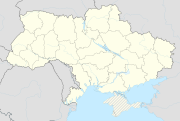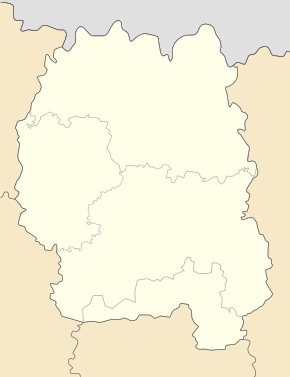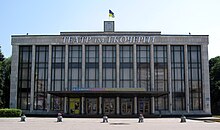Zhytomyr
| Zhytomyr | ||
| Житомир | ||

|
|
|
| Basic data | ||
|---|---|---|
| Oblast : | Zhytomyr Oblast | |
| Rajon : | District-free city | |
| Height : | 221 m | |
| Area : | 61.0 km² | |
| Residents : | 266,936 (2018) | |
| Population density : | 4,376 inhabitants per km² | |
| Postcodes : | 10000-10499 | |
| Area code : | +380 412 | |
| Geographic location : | 50 ° 15 ′ N , 28 ° 40 ′ E | |
| KOATUU : | 1810100000 | |
| Administrative structure : | 2 city racks | |
| Mayor : | Serhiy Sukhomlyn | |
| Address: | майдан Рад 4/2 10014 м. Житомир |
|
| Statistical information | ||
|
|
||
Zhytomyr ( Ukrainian Житомир ; Russian Житомир Zhitomir , Polish Żytomierz ) is a large city in the Ukraine with about 270,000 inhabitants and the administrative seat of the oblast of the same name .
The city lies in an undulating landscape on the banks of the Teteriv , a tributary of the Dnieper, and is a traffic junction, industrial center and cultural center with universities , theaters and museums . Zhytomyr is divided into the two urban rajons Bohunyja Raion and Koroljowsk Raion . The economy is dominated by mechanical engineering and - in an agricultural environment - the food industry . Excellent marble is mined nearby . The asteroid (117240) Zhytomyr , discovered by the Andrushivka observatory , was named after the city.
location
Zhytomyr is 120 km west of Kiev and 150 km south of the border with Belarus . The city is located at the intersection of two trunk roads ( M 06 , M 21 ) and two railway lines . All four lines run approximately in the four cardinal directions. In addition, the national road N 03 and the regional road P-18 lead into the city.
history
The foundation of the place goes back to about the 7th century, when the immigrant Slavic tribes settled down. The elevation to the city in the 9th century is mentioned in Old Russian chronicles from 1240. Since the 11th century the region belonged to the state of the Kievan Rus , whose capital was Kiev . It was also inhabited by Poles and Volhynians . From 1320 on, Zhytomyr belonged to Lithuania , and in 1569 the city came to the united Kingdom of Poland-Lithuania . At this time, numerous Jews settled here .
Many chapters of the city's history are connected with the liberation struggle of the Zaporozhian Cossacks against Polish rule. In 1648 Zhytomyr was taken for a few years by the Cossacks Bohdan Khmelnyzkyjs (1595-1657). After the loss of Kiev to the Russian Empire , Zhytomyr became the seat of the Kiev Voivodeship . In 1793, due to the Second Partition of Poland , the city came to the Russian Empire and became the capital of the Volhyn Governorate . In 1899, the Zhytomyr tram , which still exists today, was opened.
Heavy fighting for Zhytomyr broke out after the October Revolution of 1917 and the following Russian Civil War and foreign intervention (1918–1921). In the civil war between “ white ” and “ red ”, Nikolai Schchors and Grigori Kotowski were important troop leaders here.
After the German invasion of the Soviet Union , from 1941 to 1944, Zhytomyr was part of the German Reichskommissariat Ukraine and the rear army area as a general district . In the northern part, through which the "Northern Railway" also ran via Korosten to Brest , German control was considerably impaired by partisan units . This was increasingly true for the southern railway via Berditschew and Schepetowka to Kovel . In 1943/44 there were fierce and costly battles in the greater Zhytomyr area between the Wehrmacht and the ultimately victorious Red Army . Units under the command of Semyon Budyonny and Kliment Voroshilov took part in the battles for Zhytomyr both in the civil war from 1918 and during the Second World War . The German settlement colony of Hegewald was located south of the city from 1942 to 1944 .
After the collapse of the Soviet Union in 1991, the region became one of the 24 districts (oblast) of the now independent Ukraine, the administrative, cultural and industrial center of which the city is.
Jews in Zhytomyr

There was a significant Jewish community in Zhytomyr from the second half of the 18th century . The city was a center of the Hasidic movement and belonged to the Pale of Settlement in the Tsarist Empire . In 1891 more than a third of the city's population was Jewish (24,062 Jews out of a total population of 69,785). Together with Vilnius , this was the only place where the Russian government set up a rabbinical seminary to train rabbis in civil service. The founder of the Yiddish theater , Abraham Goldfaden, was one of the well-known students of the rabbinical seminary . The writer Mendele Moicher Sforim lived in Zhytomir, and the eminent Hebrew poet Chaim Nachman Bialik grew up here as a child .
On May 7th and 8th, 1905, a pogrom against the Jewish population was organized in Zhytomyr and 29 Jews and the Christian student Nikolaj Blinow, who wanted to come to the aid of the Jews, were murdered.
After the German invasion of the Soviet Union , Zhytomyr was occupied by German troops on July 9, 1941 , three trucks from SS Einsatzgruppe 4a entered the city immediately behind the Wehrmacht tanks , and a short time later most of the Jews from Zhytomyr and the surrounding area were murdered . This personal experience was also decisive for the Austrian Lieutenant Colonel in the General Staff of the Wehrmacht, Robert Bernardis, to join the military resistance and to sacrifice his life in Berlin on July 20, 1944 .
Attractions
Zhytomyr is known for its gardens, parks and green avenues, especially those along the rocky banks of the Teteriv , on the banks of which there is also the monument in memory of the Unknown Soldier.
The most interesting examples of the city's architecture are the former municipal building from the 17th century and the Preobrazhensky Cathedral from the 18th century on Peremohy Street . This is an Orthodox Church under the Moscow Patriarchate . Michaelskirche on Kyjiwska (Kiewer) Street from the 19th century, on the other hand, is subordinate to the Kiev Patriarchate .
Zhytomyr has several museums, including the Korolenko - and Korolev - memorials , but also the Cosmonautics Museum and the Natural History Museum, which is housed in a church building. According to an information board at the entrance to the church, it was built in the 18th century, but its architecture seems to be atypical for this time, it is more reminiscent of the 16th century.
The Zhytomyr theater is reminiscent of Central European opera houses.
In 1996, in Zhytomyr, a memorial to the victims of the tragedy in the forest of Bogunija was erected in which prisoners of war and citizens were shot in World War II. It combines a 6.5 meter high granite monument with a bronze figure by the sculptor Josef Tabachnyk .
During the Second World War, the Wehrmacht set up a military cemetery for around 2,700 fallen soldiers on a 1.7 hectare area south of the city. Today 3143 dead rest on the cemetery.
economy
In the 20th century the city expanded considerably and the number of its industrial establishments increased. In Zhytomyr there are companies in the mechanical engineering , textile, furniture, automotive and food industries.
The city is located in an agricultural area. It is the transport hub of the region and a transshipment point for wood and grain as well as the seat of an agricultural institute.
The surrounding area has rich deposits of decorative rock that is industrially extracted. Red, pink and white marble , granite and silvery labradorite are mined.
Culture
The mixed chamber choir a cappella OREYA , which was founded in the city in 1986, performs at international competitions and concerts.
Churches
Today's social situation
In December 2006, the Austrian Jesuit Georg Sporschill , who was previously active in the Republic of Moldova , founded the first of 3 care centers for street children . The social situation of the population has not improved significantly since the separation from the USSR .
Population development

Source:
Personalities
The great Ukrainian poet , writer and campaigner for justice Taras Shevchenko (1814–1861) lived and worked in Zhytomyr, the classic of Ukrainian literature Mychajlo Kozjubynskyj (1864–1913), and the Russian writer Vladimir Korolenko (1853–1921) was born and worked experienced his childhood there himself.
Zhytomyr is the birthplace of a participant in the Paris Commune , the Polish revolutionary democrat Jaroslaw Dombrowski (1836–1871), and the chief designer of the first Soviet Sputniks and spaceships Sergei Koroljow (1907–1966). Both monuments were erected there. In addition, the pianist Svyatoslaw Richter and the Zionist and Hebrew writer Aharon David Gordon come from near Zhytomyr. Furthermore, the composers Juliusz Zarębski and Borys Lyatoschynskyj were born in Zhytomyr. The world-famous bassist Alexander Kipnis in his day is also a son of the city. The chess player Ossip Bernstein (1882–1962) was born in the city. Auschwitz survivor and well-known writer Tadeusz Borowski also comes from Zhytomyr .
- Hipolit Skimborowicz (1815–1880), Polish author, journalist and editor
- Wladimir Korolenko (1853–1921), Russian writer of Polish-Ukrainian origin
- Iwan de Chaudoir (1858–1919), Russian patron
- Keni Liptzin (1863-1916), English-American Yiddish actress
- Akim Lwowitsch Wolynski (1863–1926), Russian literary critic and art scholar
- Michael Rostovtzeff (1870–1952), Russian ancient historian
- Theophil Richter (1872–1941), Russian-German musician, educator and composer, father of Svyatoslaw Richter (1915–1997), who was born near Zhytomyr
- Andrej Belogrud (1875–1933), Russian architect and university professor
- Vladimir Arzichowski (1876–1931), Russian botanist
- Alexei Shchastny (1881–1918), Russian naval officer
- Dawid Sterenberg (1881–1948), Russian painter
- Józef Turczyński (1884–1953), Polish pianist and music teacher
- Alexander Kipnis (1891–1978), Ukrainian-American opera singer
- Jan Gamarnik (1894–1937), Soviet communist activist and military
- Mykola Sziborskyj (1897–1941), nationalist activist
- Alexander Besymenski (1898–1973), Russian poet
- Mark Borissowitsch Mitin (1901–1987), Soviet historian and philosopher
- Alex Gottlieb (1906–1988), American screenwriter and film producer
- Oleh Olschytsch (1907–1944), writer and nationalist activist
- Wladimir Weksler (1907–1966), Russian physicist
- Alexander Konstantinopolski (1910–1990), Soviet chess master and theorist
- Julius Mowtschan (1913–2002), journalist in North America
- Svyatoslaw Richter (1915–1997), Soviet-Russian pianist
- Lea Nikel (1918–2005), Israeli painter
- Mieczysław Pawlikowski (1920–1978), Polish actor
- Tadeusz Borowski (1922–1951), Polish writer
- Igor Schafarewitsch (1923–2017), Russian mathematician
- Myroslaw Popovytsch (1930-2018), philosopher
- Dawid Lazarewitsch Brodjanski (1936–2017), Ukrainian-Russian prehistoric scientist , archaeologist and university professor
- Valery Shevchuk (* 1939), writer, translator and historian
- Vladimir Hachinski (* 1941), Canadian neurologist
- Josef Tabachnyk (* 1947), artist
- Rustam Akhmetov (* 1950), high jumper
- Spyrydon Babskyj (1958–2011), Ukrainian Orthodox theologian and archbishop
- Oleksandr Chusman (* 1962), Israeli chess player
- Yuri Sadowenko (* 1969), Russian general
- Anzhela Ryumschyna ( Анжела Рюмшина ; * 1975), poet
- Eugene Perelshteyn (* 1980), American chess player
- Volodymyr Lawrynenko (* 1984), classical pianist
- Vyacheslav Schabranskyj (* 1987), boxer
- Julija Jelistratowa (* 1988), triathlete
- Anastassija Tschernenko (* 1990), triathlete
- Yevgeny Grischbowski (* 1992), Russian-German music producer and DJ
- Ruslan Malinovsky (* 1993), Ukrainian football player
See also
literature
- Zhitomir , in: Guy Miron (Ed.): The Yad Vashem encyclopedia of the ghettos during the Holocaust . Jerusalem: Yad Vashem, 2009 ISBN 978-965-308-345-5 , pp. 980ff.
- Alexander Kruglov: Zhitomir , in: Martin Dean (Ed.): The United States Holocaust Memorial Museum Encyclopedia of Camps and Ghettos, 1933–1945. Vol. 2, ghettos in German-Occupied Eastern Europe: Part B . Bloomington: Indiana University Press, 2012, ISBN 978-0-253-00227-3 , pp. 1579-1581
Web links
- Żytomierz . In: Filip Sulimierski, Władysław Walewski (eds.): Słownik geograficzny Królestwa Polskiego i innych krajów słowiańskich . tape 14 : Vorovo – Żyżyn . Walewskiego, Warsaw 1895, p. 901 (Polish, edu.pl ).
Individual evidence
- ↑ a b Cities and Settlements of Ukraine on pop-stat.mashke.org , accessed on July 2, 2019
- ^ Norbert Müller: occupation, robbery, annihilation . Berlin 1980, p. 73.
- ↑ Shitomir / Shitomir war cemetery.











